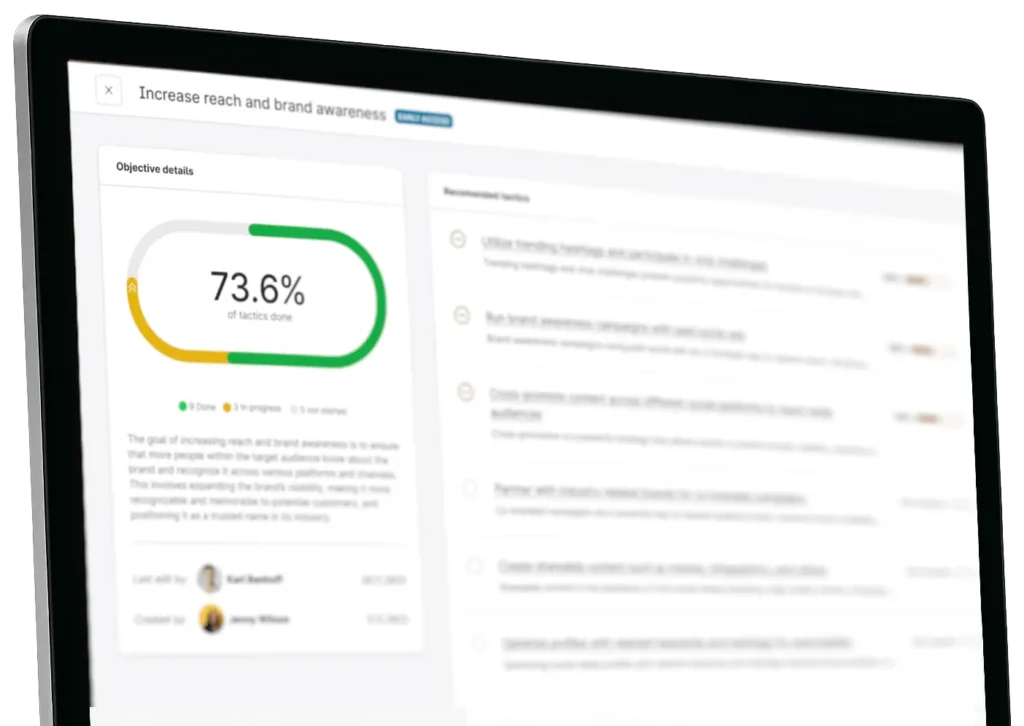As a person in charge of social media management, you live a hectic life. Between building effective strategies and overseeing multiple social media accounts, you need to stay on top of finding new opportunities for marketing growth and report on your performance – all under the pressure of time.
And if this wasn’t challenging enough, your social media teams are growing. This means you need solid management know-how to build efficient workflows and deliver results.
What is social media management?
In short, social media management is about creating and distributing content that’s tailored to your target personas, across your different social media profiles. It also includes monitoring online conversations, collaborating with influencers, as well as monitoring, measuring, and reporting on social media performance and ROI.
For brands, the true power of social media management goes far beyond just scheduling and publishing posts. It’s about igniting meaningful conversations, fostering genuine connections, and creating a vibrant community around your brand. By optimizing your strategies, you can transform curious onlookers into passionate advocates, boosting engagement rates while tapping into potential business growth.
All these tasks, which were once marginalized by businesses, have now stepped into the limelight of companies’ marketing strategies. Why? Because social media provides great money-making opportunities – on the condition you manage your social channels in an organized, efficient way.
<div id=”why-social-media-management-is-important”></div>
Why is an efficient social media management process important?
The business potential of social networks is immense, making it essential that brands invest significantly in social media. Just do so smartly.
Brands can leverage social media platforms to successfully drive their objectives across the marketing funnel, from raising brand awareness to increasing store visits. In fact, 43% of business owners use social media-sourced data for all of their business decisions.
But to be able to accomplish this, they need efficient social media teams. The more goals you want to achieve through social media marketing, the more people you’ll need to have dedicated to this strategy and to manage your social media presence.
This demand will eventually lead to building complex social media team structures. If you’re a large brand, you might even have multiple teams in different offices and regions of the world, leveraging different strategies to meet different targets.
How do you make sure all these people work together hand in hand to get the most out of your social media presence?
The answer: build an efficient social media management process.
<div id=”where-to-begin”></div>
Social media management: where do I begin?
If you’re not sure how to begin optimizing the way you manage social, don’t worry. It’s something many marketers are confused about.
To be able to start off on the right foot, you need to do three important things:
- Conduct a social media audit
- Decide on the right social media platforms
- Analyze your target audience
Why did we outline these three tasks in particular?
Completing them will provide you with fundamental information that will steer your social media marketing efforts in the right direction. As a result, you will be able to concentrate your resources on strategies that work and cut down on those that don’t.
Let’s take a closer look at each task:
Conduct a social media audit
A social media audit can always improve how you manage social media:
- It will give you a granular picture of the effectiveness of your strategy
- It will allow you to pinpoint where you’re wasting your resources
- It will show which social channels are bringing in the most results
- It will demonstrate the impact of social media on your web results
So, how do you go about performing your social media health check?
Step 1: List all of your company’s social media profiles from across your different regions and sub-brands.
Step 2: Use a social media analytics tool to review your key performance metrics. This can include follower growth, social media engagement (including the average engagement rates for particular months), publishing frequency, most engaging content formats, top-performing posts, traffic sources, community sentiment, question response rate, average response time, audience interests, demographics, and behaviors.

Step 3: Analyze the data and identify areas of improvement. For example, if you see a dip in your engagement volume, it might be a result of low content quality, inaccurate targeting, or wrong publishing frequency.
That’s exactly the type of information you need to start taking the right steps to fix them and make your social media management activities more efficient.
Decide on the right social media platforms
Another critical element of managing social media more efficiently is picking the right platform.
After you conduct a social media audit, it might turn out that some platforms simply don’t work well for your brand. In that case, you should take the time to understand the effort it will take to get the results you need.
A lot also depends on where your audience is. If, during your research, you find out your audience is mostly on X, for example, but your presence on the platform is far from strong, then you should obviously seek to improve.
If your results aren’t that great and your audience is somewhere else, you might consider shifting your resources to a different channel. But before you do, ask yourself the following questions:
- What are my business objectives (improving brand awareness, lead generation, website traffic, conversions, etc.)? Will I be able to meet my business objectives on the platform? How much will I have to spend to meet my goals?
- Will I be able to perform efficiently enough to generate positive ROI on the platform? Will the amount be enough to justify the cost of marketing on the platform?
- What are the demographics of the community on the platform? And do they match the demographics of the audience I’d like to reach?
- Is my target audience present and active on the platform? Will I be able to reach them effectively?
- How popular among marketers is the platform? How much content will I have to produce to stand out?
- Is my direct competition present on the platform? How are they doing? Will I be able to outperform them?
If you need help picking the right platform for your business, here’s a little cheat sheet:

Analyze your target audience
Analyzing your social media community is everything when it comes to managing social media efficiently. There are plenty of benefits to analyzing your followers – including building stronger customer relationships, creating more relevant content, and boosting social media conversions.
On the flip side, if you don’t do market research beforehand, you’re at risk of getting on the wrong path, wasting both money and resources.
How do you build a detailed picture of your social media audience?
Start off by segmenting your audience into personas according to their shared characteristics – you can do that using this free customer persona template.
Or, if you want to make your life easier, you can let AI do the job for you.
It’s likely that your customer personas will be diverse. For example, you can have a group of teens interested in sports and a group of 30-year-olds following Digiday’s Facebook page and interact with their content.
Having this information will allow you to make better use of your resources by concentrating on doing what works best with your community. Need help analyzing your target audience on social media? Check out Emplifi’s social media analytics guide.
<div id=”social-media-management-tools”></div>
Stock up on the right social media management tools
Advanced social media tools are essential to building, executing, and measuring your social media marketing strategy effectively.
Here’s what you’re going to need:
Top- to middle-of-the-funnel tools
Analyzing your top- to mid-funnel audience is especially important. That’s because people at these stages are your potential customers.
The better you know these users, the more effectively you’ll be able to nurture them towards conversion with tailored marketing campaigns.
So, which tools are going to come in handy at this point?
Native social media analytics. The audience data you can get from social media platforms is quite detailed and includes:
- Facebook audience insights: demographics, page likes, locations, activity
- Instagram insights: top locations, times, and days when your followers are most active
- Twitter analytics: demographics, lifestyle, consumer behavior, mobile footprint
- LinkedIn analytics: demographics, job function, seniority, industry, company size, employment status
- Audience Analytics: This enables you to see your Facebook audience grouped into personas based on their demographics, interests, and behaviors. As a result, you can save the time you’d have to spend on manual audience research.
You’ll also be able to immediately turn the result of your audience analysis into action.
Bottom-of-the-funnel tools
Analyze the bottom-of-the-funnel users and use customer relationship management (CRM) tools to focus on every part of the customer experience (CX).
These will give you a better understanding of the people who purchased your products, including their demographics, the touchpoints on their customer journey, and the content that eventually made them hit the Buy button.
Content management tools
Content creation is an important part of the social media management process – but also a really challenging one. To make your content workflow faster and more organized, try these tools:
Content ideas tools
- Social media monitoring – discover trending topics online that you can tap into
- Social media analytics – see what your competitors are posting and get inspired by some of their most successful ideas
- Audience analysis – understand the content your audience responds to positively
- Content management tools – find trending articles online that you can repost and discover thousands of top social media posts that will resonate with each of your audience personas
Content creation tools
Social media editorial calendars
- Google Calendar – use Google’s visual calendar to easily slot your posts
- Google Spreadsheet – create your own editorial calendar tailored to your needs
- Free calendar templates – save time with pre-made social media calendar templates
- Content calendar scheduler – access a visual breakdown of your social media content, schedule content, and review posts, and have your team work on all content-related tasks directly within the calendar
Social media publishing tools
Social media publisher – manage social media publishing more efficiently by posting to multiple platforms with a single click. Plus, you’ll get precise recommendations on the best publishing times, so you can maximize your visibility and interactions.
Social media listening tools
Keeping tabs on online conversations around your brand is crucial to understanding the real impact of your campaigns that goes beyond just likes and comments.
- Social listening – monitor social media for topics and queries, uncover the conversations about your brand, and analyze the sentiment around them
- Google alerts – create alerts for relevant phrases and topics appearing online and receive regular email reports so you never miss a mention of your brand
Influencer collaboration tools
Managing influencer relationships is a relatively new addition to social media managers’ scope of work. Yet, it’s also become one of the most important tasks on their to-do lists.
Here’s how you can effectively manage influencer marketing-related activities:
Find influencers tool with AI – discover the most relevant influencers for your social media audience in seconds. Get an instant overview of their demographics, audience size, and social media engagement, along with an easy-to-understand performance score, so you can pair up with the most effective influencers.
Social customer care tools
Social media is a go-to channel for many customers to express their opinions or ask questions about your business. To be able to manage all the incoming messages, you might need:
Community management – Interact with your community in an organized way with automated notifications, and defined team roles and responsibilities. View your incoming messages across channels in one spot and monitor your teams’ efficiency with filterable feeds, so you can provide top-notch customer service.
Social customer care– It’s crucial to recognize that social media managers may not always have the expertise or resources to address every issue that arises within their community. Therefore, it’s essential for organizations to provide them with the necessary support and resources to escalate and resolve these issues efficiently and improve the overall experience.
Social media analytics tools
Monitoring social media performance is critical to understanding the impact of your campaigns, identifying the most successful tactics, and fixing the shortcomings – which is why it’s so important to have the right tools.
Social media analytics tools – get a detailed understanding of your performance across channels in terms of all the key metrics, including:
- Overall engagement
- Distribution of interactions
- Most engaging post types
- User activity
- Number of interactions per 1,000 fans
- Number of fan posts
- Most engaging posts overview
- Share of promoted posts and interactions they generated
You will also be able to see how you compare to your main rivals in terms of these metrics to find out who’s ahead of the game. And to add even more context to your performance, you can benchmark your ad spending and video strategy effectiveness against your industry, region, or country.
- Google Analytics – understand which social media platforms drive the most traffic to your website
<div id=”social-media-personas”></div>
How to manage and analyze social media audience personas
As mentioned before, analyzing your audience personas should be the foundation of your social media strategy. Before you create any content piece or launch campaigns, you need to understand your community on a deeper level.
How do you go about managing and analyzing your buyer personas?
- Step 1: Analyze audience data. The more information you have, the more accurate picture of your audience you’ll be able to build. Ideally, you’ll be using social media analytics software that aggregates multiple audience data sources, saving you time and manual labor. Pro tip: Some audience information won’t be available in platforms’ native analytics or even Google Analytics. If you need answers to very specific questions, such as one’s favorite travel destination, consider running polls or doing market research.
- Step 2: Consolidate your audience data. After you pull the data, it will likely be scattered and difficult to read. To get a holistic view of your social media community, you need to bring all the data together and analyze it in a single spot.
- Step 3: Define your audience personas. Your social media audience is diverse: there are groups sharing different demographics, locations, behavior, and interests. By segmenting your audience according to these characteristics, you’re able to get a more detailed understanding of your personas. As a result, you can create tailored content that sparks engagement and effectively nurtures your community down the marketing funnel.
- Step 4: Check up on your audience personas regularly. It’s not enough to analyze your community once and rely on this data for years. Keep in mind that your audience is constantly evolving – there are new people starting to follow your page and your “old” followers might develop an interest in different content. To be able to spot these trends and act on them in time, you need to analyze your audience personas on a regular basis.
See this guide to target audience analysis for a more comprehensive insight into researching your social media audience.
<div id=”social-media-content-creation”></div>
How to manage social media content creation
Once you’re done with analyzing your audience personas, you should have an idea of the direction your content strategy should take.
Yet, deciding on content formats and topics is not everything. As your business scales up, you’ll face the challenge of producing big volumes of content at a fast pace. To be able to tackle this issue, you’re going to need an optimized content workflow.
Here’s how you can efficiently manage social media content creation activities:
Step 1: Integrate your social media calendar with national holiday content
Check out Emplifi’s 2024 social media calendar filled with all the national holidays through the year. This list will help make social media planning easy while boosting engagement rates with your audience.
Step 2: Assign team roles and responsibilities
Assign team roles and responsibilities. This step is critical to improving your efficiency, whether you’re an agency or brand with multiple offices around the world. To produce content efficiently, you should have the following roles on your team:
- Content manager: In charge of creating a social media content strategy, managing an editorial calendar, distributing content promotion budget, and measuring KPIs.
- Content creator: In charge of coming up with relevant content ideas, creating engaging posts, and optimizing them for different platforms.
- Content editor: In charge of collaborating with all the people involved in content creation across the company, reviewing posts, and approving them for publishing.
It’s also necessary that you have a structured approval process in place. With the sheer amount of content you need to produce, it’s easy to get bogged down by unclear procedures. To ensure that no post gets stuck in a line, manage all your content in a unified system.
Step 3: Leverage social media persona data
Leverage data on your social media audience personas. Pay attention to their interests and the influencers they follow. This information will help you focus your efforts on creating tailored content, making this area of social media management much more efficient.
Remember that the more personalized your social media content, the more effective it is in driving your business objectives.
See this guide for step-by-step instructions on how to personalize your social media marketing activities.
Step 4: Get content ideas with competitive analysis
Round up content ideas by looking at the competition, utilizing social listening to monitor and join online conversations, analyzing your personas’ page with analytics, and curating interesting articles.
Step 5: Figure out the ideal social content cadence
Determine how much content you need to create. Obviously, you don’t want to put out too little and disappear from your audiences’ newsfeed or publish too much and appear like spam. Knowing how many posts you need to create on a daily or weekly basis can help you manage your resources better and be more efficient.
How much content should you be creating for each social platform?
- Facebook: 1-2 posts per day
- TikTok:1-4 posts per day
- Instagram: 1-3 posts per day
- Twitter: 3-30 posts per day
- LinkedIn: at least 2 posts per week, and no more than 1 post each business day
- Pinterest: 3-25 pins per day
- YouTube: upload 1 video per week
Step 6: Create content with a quality content creation tool
Create amazing content using a variety of available online content creation tools that we discussed before. Pay attention to the formats that work best on each platform:
If you want to scale your content production and work more efficiently, you need a comprehensive solution. With Emplifi, you can easily manage all your social media content for each day, week, or month. You’ll be able to save time by having your team schedule and publish posts with images, videos, and user mentions directly within the calendar.
Additionally, thanks to the visual layout of the calendar, you will be able to get an instant overview of your social media content.
Step 7: Monitor and report on social content performance
Monitor your content performance and report on it. Tracking how your posts resonate with your personas allows you to identify the most effective elements of your campaign, and focus your resources on replicating them in the future. Here are the metrics you should be tracking:
- Awareness metrics: engagement overview, number of interactions per 1,000 followers, top-performing posts
- Campaign goal completions: link clicks, sign-ups, purchases
You can get an instant overview of these metrics with customizable dashboards. And to keep your team in the loop on the latest data, leverage automated reports that are sent straight to the team members’ inboxes as frequently as you need.
<div id=”social-media-listening”></div>
How to manage social media listening
Social media listening is an important element of the social media management process. If done on a regular basis, it can help you complete multiple tasks, including:
- Monitoring @mentions and how your campaigns resonate on social media
- Finding out what social media users are saying about your competitors
- Providing better customer care
- Identifying new social media influencers and brand ambassadors
- Spotting and preventing any brand-related social media crises
- Pinpointing larger conversations your business should join
How should you listen on social media?
Step 1: Pick the right keywords in queries. Depending on the task you want to complete, you will need to pick the right words you want to hone in on.
For example, if your goal is to find influencers through listening, you should start by creating queries related to your campaign topic. Within the query, list relevant keywords, hashtags, and mentions you want to track. Finally, pick the platform you’d like to monitor, along with the default language and region. As a result, you will capture exactly what you are interested in.

Step 2: Listen and analyze. After you select the keywords you want to track, use a social media listening tool to start monitoring them. You can use the data you’ll get in multiple ways, depending on the objective:
- Campaign monitoring: See what people are saying about your brand and content and join the conversation to increase engagement.
- Competitive intelligence: See how people are responding to your competitors’ content, and look into the volume and tone of their responses to draw actionable conclusions you can leverage in your own strategy.
- Top-quality customer care: Keep tabs on the incoming questions and comments, so you can respond ASAP to improve customer satisfaction and enhance brand image.
- Brand advocates and influencers: Understand who’s mentioning your brand to be able to leverage their impactful voices to reach new audiences.
- Crisis management: Spot complaints and negative comments in no time, so you can prevent conflicts from escalating.
Make sure you look into the sentiment of your keywords or brand mentions. This will help you understand the context of discussions around your brand and provide more informed responses.
<div id=”social-media-influencers”></div>
How to manage social media influencers
Not that long ago, managing influencer relationships was the job of PR agencies. However, with the increasing popularity of influencer marketing, collaborating with influencers became an inherent part of social media management. The global market for influencer marketing is experiencing rapid growth, with its popularity skyrocketing. Projections indicate that the market size is anticipated to reach a substantial 22.2 billion U.S. dollars by the year 2025.
Luckily, with the rise of end-to-end influencer management tools, this task has become much easier. Let’s take a look at how to build a successful influencer marketing strategy:
Step 1: Define your goals and KPIs
To define goals and KPIs for a social influencer program, start by:
- Clarifying your objectives.
- Identifying your target audience and understanding their demographics and interests.
- Transforming your objectives into specific, measurable goals, such as a percentage increase in social media followers or brand mentions.
- Selecting relevant KPIs that align with your goals, and ensure they can be effectively measured.
This process will help you track progress and evaluate the success of your social influencer program.
Some of the most popular influencer marketing goals include:
- Raising brand awareness: volume of social shares, brand mentions, earned media, reach, direct traffic, brand search
- Increasing sales: volume of sales qualified leads (SQLs), sold products or services
Reaching new market segments: reach, volume of users other than your usual audience personas engaging with your content, visits to your website, purchasing your products or services
Step 2: Find the right influencers for your audience
You shouldn’t work with someone just because this person is hugely popular or has worked with multiple international brands before. Instead, focus on finding someone who is the right match for your audience, even if they’re niche. So, how do you find influencers your audience trusts?
- Use an AI influencer search tool: Skip manual research and let AI provide a selection of top social media influencers that are the best fit for each of your audience personas.
- Use social media listening: Find out who’s already mentioning your brand or talking about the keywords related to your business or industry. Then, see how well the influencer matches your audience personas to be able to assess if you could strike up a fruitful collaboration.
Step 3: Understand the performance of the influencers
To ensure you’re partnering with someone who’s not only the right match, but also effective, review their performance using social media analytics tools. Pay attention to metrics such as engagement, follower growth, and promoted posts efficiency, which will give you an idea of the influencer’s effectiveness.
Step 4: Get to know the influencer
Talk to them about your goals, expectations, campaign ideas, and let the influencer do the same. The more campaign details you provide, the better your collaboration with the influencer will be. Find out how to develop successful relationships with social media influencers.
Step 5: Work on content strategy
Many marketers make the mistake of forcing influencers to leverage certain content formats, topics, or publishing frequencies. In reality, though, it’s the influencers who should be deciding on the final shape of the campaign. After all, they know best how to engage their audiences in a meaningful way. Get ideas for your next influencer campaign with our blog discussing the untapped opportunities for influencer marketing.
Step 6: Measure your performance
To find out how effective your influencer collaboration is, you need to closely monitor your performance throughout the campaign. Don’t forget to compare the ROI of your influencer campaign to the ROI of your other digital marketing activities – it will allow you to estimate how cost-effective your influencer collaboration was.
Check out this Influencer marketing infographic to learn more about what steps your brand can take to boost your influencer marketing program.
<div id=”social-media-customer-care”></div>
How to manage social media customer care
Excellent customer service on social media is key to acquiring and retaining a loyal, engaged audience.
It also has a direct impact on a company’s revenue. According to Statista, 60% of the global population are active social media users. It’s essential for every business to implement a social media strategy to engage with its customers. That’s why customer care on social media is crucial. Now let’s look at how your team can provide top-notch customer service on social media:
Step 1: List the platforms where your customers are reaching out to you most frequently, so you can focus your time and resources on managing these channels.
Step 2: Assign roles and responsibilities in your social media customer care team. You can have a designated person for each platform or topic (e.g., technical product-related questions vs. complaints). It’s also a good idea to have one person monitoring all the customer care activities – someone making sure the responses are appropriate and approving the outgoing messages.
Step 3: Create customer service guidelines. Doing so will enable you to keep your responses coherent and aligned with your brand’s tone of voice. Should you appear friendly or professional? Should you reply to questions in the comment section or follow up in a direct message? Should you proactively engage in conversations with your customers, even if they are not directly related to your business? These are some of the issues that a style guide will help clear up.
Step 4: Monitor social channels by listening for brand mentions, comments, and questions. Give answers to a maximum number of customers each day to provide timely help, join conversations while they’re still relevant, and spot conflicts before they develop. If a crisis does escalate, though, keep calm and read our article on how to manage a social media crisis.
Step 5: Report on your performance. Just like with other social media marketing activities, customer service is something that should be frequently reviewed. Reporting on your customer care performance in terms of the types of queries you’re receiving or average response time will allow you to identify gaps and fix any shortcomings.
<div id=”social-media-reporting”></div>





















